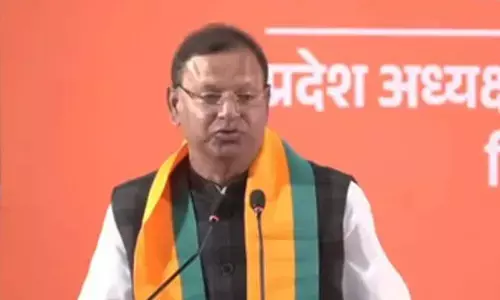Wake-up call for Cong, AAP

Kuldip Nayar: Wake-Up Call for Congress, AAP, This is not the first time that the Congress has been decimated, getting only 44 seats in the 543-member Lok Sabha. The party met more or less a similar fate in the 1977 election held after the emergency.
This is not the first time that the Congress has been decimated, getting only 44 seats in the 543-member Lok Sabha. The party met more or less a similar fate in the 1977 election held after the emergency. Mrs Indira Gandhi, the architect of the emergency and her extra-constitutional son, Sanjay Gandhi, too lost in the polls. Yet, the Congress retained the three southern States—Andhra Pradesh, Karnataka and Kerala. Even the overall tally was around 150. It was, indeed, a defeat but not a rout as it has been the case now.

People were then angry over the excesses committed during the emergency. They felt relieved after punishing the Congress for all that it did. They brought back the party after they found the Janata Party, the successor, floundering. Theirs was anger, not alienation.
This time it is a vote against non-governance and the scams which tumbled one after another from the party’s cupboard. The disillusionment is deeper than ever before, the belief that the party cannot give a clean and efficient government.
If Narendra Modi and his Bharatiya Janata Party (BJP) manage to deliver on the agenda of development and employment—they have secured 282 seats—then the return of the Congress will be difficult even in the next election in 2019. Much will depend on Modi. The speech he has delivered before the elected MPs of his party is so emphatic in tone and so promising in tenor that he looks like settling in at least for a decade. The delivery on progress and jobs may make the return of the Congress still more difficult in the foreseeable future.
Modi is intelligent enough to realise that the Hindutva card is not necessary to play when the BJP-RSS combine has made inroads in the southern states as well. If the middle class had not been influenced by soft Hindutva, such a sweep would not have been possible. That is the reason why Modi is underlining development. He wants to show that the BJP is capable of pulling people out of poverty in which at least one-third in the country are hopelessly stuck.
True, the outgoing Prime Minister Manmohan Singh was an open book. But there was very little written in terms of performance. The ever-increasing prices and the arrogance of power botched even the average growth rate of nearly 8 per cent. The Congress problem was never Manmohan Singh who, in any case, is a yesterday story. How does the party disentangle itself from the dynasty and stand on its own is the issue it is facing today.
Party president Sonia Gandhi and her son, Rahul Gandhi, ran the government and the party. Now that both have failed who do the people turn to? Both have offered to resign but the working committee has refused to accept their resignations. After all, they are the ones who constitute the leadership. They have not allowed anyone else to grow or emerge. The Congress has nowhere to go except the dynasty which has run the party since independence. It was said about Jawaharlal Nehru that he was like a banyan tree which did not let anything beneath to grow. The Congress was dependent on him. Consequently, none in the party emerged to be its natural choice when he died. Mrs Indira Gandhi, his daughter, whom he had groomed, was not acceptable to the party at that time. Lal Bahadur Shastri was the natural choice because he was the consensus candidate, although Morarji Desai threw his hat in the ring, knowing that he had the support of most State Chief Ministers. But the then Congress president, K. Kamaraj, found him too rigid and preferred Indira Gandhi.
The party of today is entirely different because Kamaraj and Mrs Indira Gandhi are rolled into one person: Sonia Gandhi. The party does not have to introspect. She has to do so. Is she willing to give up control over the party, state leaders and others? Is she ready to accept the criterion of work at the grassroots rather than being sycophants to her? The suggestion that the party’s office-bearers should be elected carries weight. But something similar was tried and found to be a mere exercise because bogus voters proliferated.
Maybe, the office of party president and that of the Prime Minister should be combined. Mrs Indira Gandhi did so. She, as Prime Minister, found the Congress president in the way. This may be very much a presidential form of governance. But that is how Narendra Modi is going to function. His election campaign showed that. The presidential form is, no doubt, democratic but it gives room for authoritarianism. He has already announced that he would also head the National Democratic Alliance. The history is replete with such examples. The Soviet Union was run like that. After several decades, it got disintegrated because of concentration of power at Moscow. Even now Russian President Vladimir Putin rules in the same style and this can be seen in Moscow’s attitude towards Ukraine. America has escaped dictatorship even though it has the presidential system because of the checks and balances. The Congress, the US parliament, is strong.
The Congress Party in India can bounce back because it is the only alternative available. In the minds of the people there are only two parties, Congress and the BJP. When they do not find one delivering, they return the other which they had rejected previously. They are stuck with the two.
The Aam Aadmi Party (AAP), a movement against corruption which converted itself into a political party, can be an alternative provided it expands its base. The AAP has secured less than three per cent of votes in the election. Moreover, the anti-corruption stand it has taken is laudable. But there has to be an ideology or vision if it wants to attract voters.
It messed up a great opportunity it got in Delhi. Even if the party has admitted its mistakes, though belatedly, it will take time for that blemish to go. The party has to work in the field. It cannot depend on slogans alone. Power that has got concentrated at the top, more specifically its leader Arvind Kejriwal, must spread. There is no other way. This holds good for Modi as well.



















